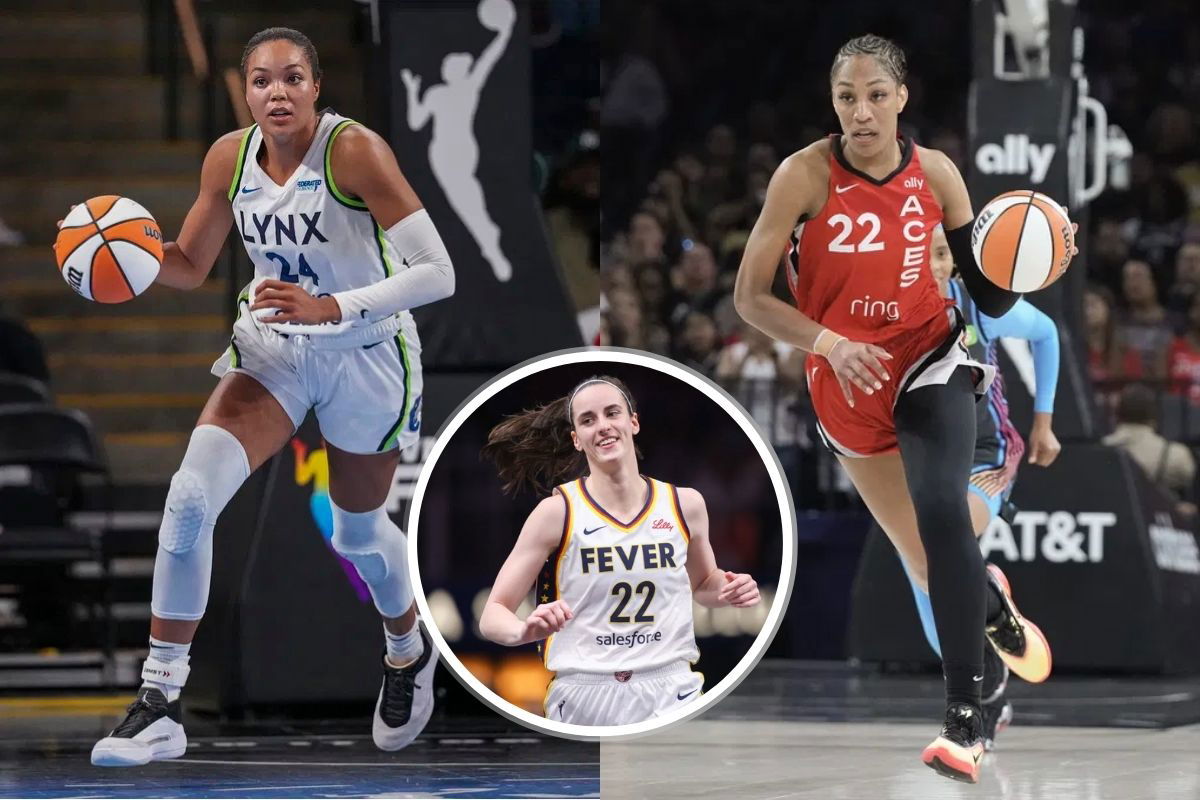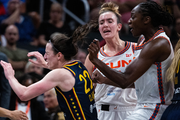
Imago
Image Credits: IMAGN

Imago
Image Credits: IMAGN
As the WNBA MVP debate hits a high note on September 21, two names tower above all others: A’ja Wilson and Napheesa Collier. Wilson has been a force of nature this season. She’s averaging 23.4 points per game and 10.2 rebounds. She’s also leading the league in blocks and ranking among the very top in rebounds, steals, and scoring. Collier, meanwhile, has done something no one else has quite pulled off: a 50-40-90 shooting line (53.1 FG, 40.3 3PT, 90.6 FT) while averaging 22.9 points and 7.3 rebounds. Wilson’s late-season surge has shifted many pundits toward her. However, a WNBA analyst has tipped the scales back in Collier’s favor, using the impact of Caitlin Clark.
Watch What’s Trending Now!
One might wonder where the newcomer, the Fever guard, fits into the debate for the coveted MVP title alongside Collier. Their only connection on the court comes from being the opposing team captain for this year’s All-Star game. But WNBA analyst Michael Curley believes Clark’s 2024 run is a perfect example for Collier’s 2025 MVP run. And he has a solid argument for it, which starts from the very beginning of the 2025 regular season.
During the latest episode of Mick Talks Hoops, Curley put it plainly: “We are not taking into account the fact that Napheesa Collier had one of the greatest starts to a season ever. She had one of the greatest 20-game starts of the season ever. But yet, we’re rewarding A’ja for not being one of the top five players in the WNBA until her team lost by 53 points, and then she just… played like an MVP.”
ADVERTISEMENT
It is true that Wilson is undeniable right now. Still, Collier deserves serious consideration, perhaps more than many realize. The Lynx posted one of the league’s best records, and Collier has been the engine on both ends. She’s been the best player on the best team in the league, which deserves some MVP-caliber performance. Her shooting percentages are historic, even regardless of volume. On the other hand, Wilson’s counting stats sometimes hide quieter stretches earlier in the season when Las Vegas was just middling. And that is where Caitlin Clark comes in.
According to the WNBA analyst, “Caitlin Clark finished fourth last year after game 10. I don’t think Caitlin Clark played like an All-Star the first 10 games, but for the last 30 games of last season, Caitlin Clark was the best player in the WNBA.” Curley points out that this is the type of recency bias that skews the voting of the juries towards better performance in the latter half of the season. All he wants is a fair assessment for Collier, because this very bias cost her the MVP tag last season.

Reuters
Paris 2024 Olympics – Basketball – Women’s Semifinal – United States vs Australia – Bercy Arena, Paris, France – August 09, 2024. Napheesa Collier of the United States and A’Ja Wilson of the United States during the match. REUTERS/Evelyn Hockstein
“We punished Phee last year because A’ja just started off the season so well, and Phee ended the season as the by far better of the two of them. And then it flips this year, and the difference is Phee’s is the [number] one seed… But because Phee doesn’t end the season as well as A’ja, A’ja wins the MVP. But last year, A’ja didn’t play as well as Phee, and A’ja was unanimous,” said Curley.
ADVERTISEMENT
Last year, A’ja Wilson won the MVP title with all 67 first-place votes (670 points) in her favor. Napheesa Collier finished in second place with 467 points. She was averaging 20.4 points, 9.7 rebounds, and 3.4 assists. On the other hand, Wilson got 26.9 points, 11.9 rebounds, and 2.3 assists. Though there is a difference, Collier’s stats were inflated by her dominant run in the latter half. The same is happening with Wilson this year. So by giving the example of Caitlin Clark, the WNBA analyst points Wilson might win again.
ADVERTISEMENT
As Curley puts it, “This year, Phee in my opinion was better than A’ja was last year,” signalling who he wants to win MVP this year. Interestingly, the Fever guard was also in MVP contention this year, although just on paper.
Caitlin Clark was in MVP contention alongside Collier and Wilson this year
Sounds strange, right? Clark has barely played 13 games this season, thanks to her recurring injuries. But it is true she was in the race for MVP contention this year. And this comes not just from fans but from the General Managers of the WNBA. Back in May, the WNBA surveyed all general managers, asking them 40 questions ahead of the new season. One of the glaring questions was: who will win the 2025 WNBA MVP? Interestingly, on that list was the 2024 ROTY, Caitlin Clark.
ADVERTISEMENT
Eight percent of the General Managers of the WNBA were convinced the Fever guard was an MVP candidate. However, Napheesa Collier was the poll leader with 67 percent votes, and A’ja Wilson was second with 25 percent votes. While Clark was third in the MVP race pre-season, she left Collier and Wilson behind in one other major category.
The question given to GMs was: “If you were starting a franchise today and could sign any player in the WNBA, who would it be?” And leaving both the MVP-caliber players behind, Clark secured 50 percent of the votes. A’ja Wilson got 33 percent votes, and Collier split the rest with rookie Dominique Malonga. The Fever guard’s popularity underscored how quickly she became a cornerstone-level player in the eyes of the league’s decision-makers.
Top Stories
Cowboys Fire Defensive Coordinator Matt Eberflus: Contract, Salary, NFL Earnings & More

Adam Peaty Faces Gordon Ramsay’s Sly Dig Amid Parents’ Controversial Wedding Absence

Russell Wilson Announces Retirement Stance as Giants QB Shares Hidden Injury News

Marina Mabrey Is Raising Eyebrows Again With Fiery Unrivaled Confrontation

Huge Fire Destroys Over 125-Year-Old Golf Club Designed by 5x Open Winner in London – Report

Dolphins Reportedly Indecisive About Mike McDaniel as GM Search Kicks Off

Clark’s actual 2025 season never reached those lofty expectations. She appeared in only 13 games for Indiana, averaging 16.5 points, 8.8 assists, 5.0 rebounds, and 1.6 steals. Multiple injuries, including groin issues and a bone bruise in her left ankle, ultimately shut her down for the season in early September. The Fever were left to fight for playoff positioning without her on the floor. Even so, her mere mention in MVP conversations shows how narrative, reputation, and preseason hype can shape awards debates.
ADVERTISEMENT
Her case, or rather, her lack of a real case, becomes a mirror for the current Wilson vs Collier race. Collier had the blazing start that analysts argue should matter, while Wilson’s torrid finish is fresh in voters’ minds. Clark’s preseason standing illustrates how voters and GMs can be swayed by timing and perception, not just full-season output. Her absence clears the field for the two frontrunners but keeps the focus on how easily momentum can tilt MVP voting.
Clark’s name in the preseason MVP race highlights how expectations and narrative often influence the league’s biggest award. Even with limited appearances, she captured enough respect to be in the conversation. That context sharpens the focus on the actual duel between Collier and Wilson. Collier delivered elite play from day one, propelling Minnesota to the top seed, while Wilson’s late-season dominance reminded everyone why she is a two-time MVP. When voters decide on September 21, they will be weighing consistency against momentum, a dynamic that Clark’s situation helps illuminate. Regardless of who wins, this season’s MVP debate will be remembered as one of the most compelling in WNBA history.
ADVERTISEMENT
ADVERTISEMENT
ADVERTISEMENT

